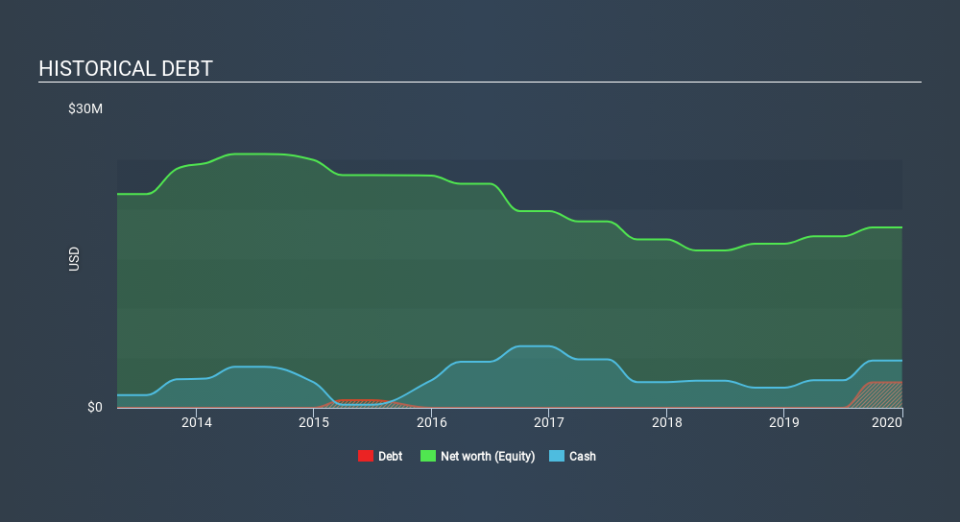These 4 Measures Indicate That IndigoVision Group (LON:IND) Is Using Debt Safely

Warren Buffett famously said, 'Volatility is far from synonymous with risk.' It's only natural to consider a company's balance sheet when you examine how risky it is, since debt is often involved when a business collapses. As with many other companies IndigoVision Group plc (LON:IND) makes use of debt. But is this debt a concern to shareholders?
What Risk Does Debt Bring?
Debt and other liabilities become risky for a business when it cannot easily fulfill those obligations, either with free cash flow or by raising capital at an attractive price. Ultimately, if the company can't fulfill its legal obligations to repay debt, shareholders could walk away with nothing. However, a more common (but still painful) scenario is that it has to raise new equity capital at a low price, thus permanently diluting shareholders. Of course, the upside of debt is that it often represents cheap capital, especially when it replaces dilution in a company with the ability to reinvest at high rates of return. When we examine debt levels, we first consider both cash and debt levels, together.
View our latest analysis for IndigoVision Group
What Is IndigoVision Group's Net Debt?
As you can see below, at the end of December 2019, IndigoVision Group had US$2.56m of debt, up from none a year ago. Click the image for more detail. But on the other hand it also has US$4.76m in cash, leading to a US$2.19m net cash position.
How Strong Is IndigoVision Group's Balance Sheet?
Zooming in on the latest balance sheet data, we can see that IndigoVision Group had liabilities of US$16.3m due within 12 months and liabilities of US$4.15m due beyond that. Offsetting this, it had US$4.76m in cash and US$15.9m in receivables that were due within 12 months. So its total liabilities are just about perfectly matched by its shorter-term, liquid assets.
This state of affairs indicates that IndigoVision Group's balance sheet looks quite solid, as its total liabilities are just about equal to its liquid assets. So it's very unlikely that the US$19.4m company is short on cash, but still worth keeping an eye on the balance sheet. Succinctly put, IndigoVision Group boasts net cash, so it's fair to say it does not have a heavy debt load!
It was also good to see that despite losing money on the EBIT line last year, IndigoVision Group turned things around in the last 12 months, delivering and EBIT of US$2.2m. There's no doubt that we learn most about debt from the balance sheet. But it is future earnings, more than anything, that will determine IndigoVision Group's ability to maintain a healthy balance sheet going forward. So if you want to see what the professionals think, you might find this free report on analyst profit forecasts to be interesting.
Finally, a business needs free cash flow to pay off debt; accounting profits just don't cut it. IndigoVision Group may have net cash on the balance sheet, but it is still interesting to look at how well the business converts its earnings before interest and tax (EBIT) to free cash flow, because that will influence both its need for, and its capacity to manage debt. Over the last year, IndigoVision Group actually produced more free cash flow than EBIT. That sort of strong cash generation warms our hearts like a puppy in a bumblebee suit.
Summing up
While we empathize with investors who find debt concerning, you should keep in mind that IndigoVision Group has net cash of US$2.19m, as well as more liquid assets than liabilities. And it impressed us with free cash flow of US$4.0m, being 186% of its EBIT. So we don't think IndigoVision Group's use of debt is risky. When analysing debt levels, the balance sheet is the obvious place to start. However, not all investment risk resides within the balance sheet - far from it. For instance, we've identified 3 warning signs for IndigoVision Group (1 is significant) you should be aware of.
Of course, if you're the type of investor who prefers buying stocks without the burden of debt, then don't hesitate to discover our exclusive list of net cash growth stocks, today.
If you spot an error that warrants correction, please contact the editor at editorial-team@simplywallst.com. This article by Simply Wall St is general in nature. It does not constitute a recommendation to buy or sell any stock, and does not take account of your objectives, or your financial situation. Simply Wall St has no position in the stocks mentioned.
We aim to bring you long-term focused research analysis driven by fundamental data. Note that our analysis may not factor in the latest price-sensitive company announcements or qualitative material. Thank you for reading.

 Yahoo Finance
Yahoo Finance 
